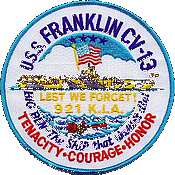
Contributed by Joe Radigan

[...] Before dawn on 19 March 1945, Franklin, Captain Leslie E. Gehres, commanding, launched a fighter sweep against Honshu and later a strike against shipping in Kobe Harbor. Suddenly, a single enemy plane pierced the cloud cover and made a low level run on the gallant ship to drop two semi-armor piercing bombs. One struck the flight deck centerline, penetrating to the hangar deck, effecting destruction and igniting fires through the second and third decks, and knocking out the combat information center and air plot. The second hit aft, tearing through two decks and fanning fires that triggered ammunition, bombs, and rockets. Franklin, within 50 miles of the Japanese mainland, lay dead in the water, took a 13° starboard list, lost all radio communications, and broiled under the heat from enveloping fires.
Many of the crew had been blown overboard, driven off by fire, or had been killed or wounded, but the 106 officers and 604 enlisted who voluntarily remained on board saved their ship through sheer valor and tenacity. The casualties totaled 724 killed and 265 wounded, and would have far exceeded this number except for the heroic work of many survivors. Among these [was] Lieutenant Commander Joseph T. O'Callahan, ChC (SJ) USNR, the ship's Roman Catholic chaplain, who emerged "as a soul-stirring sight. He seemed to be everywhere," an eyewitness recounted later [CDR Joe Taylor, XO], "giving Extreme Unction to the dead and dying, urging the men on and himself handling hoses, jettisoning ammunition and doing everything he could to help save our ship. He was so conspicuous not only because of the cross daubed with paint across his helmet but because of his seemingly detached air as he went from place to place with head slightly bowed as if in meditation or prayer." Lieutenant (Junior Grade) Donald A. Gary also emerged a hero, calming anxious men seemingly trapped in a smoke-filled compartment. After finding an exit after repeated attempts, he led some 300 of his shipmates to safety. He later organized and led fire-fighting parties to battle the blazing inferno on the hangar deck, and entered number three fireroom to raise steam in one boiler, braving extreme hazards in so doing. Both men subsequently received Medals of Honor for their bravery; ships were also named for them [see USS O'Callahan (DE-1051) and USS Gary (FFG-51)]. Light cruiser Santa Fe (CL-60) similarly rendered vital assistance in rescuing crewmen from the sea and closing Franklin to take off the numerous wounded.
Franklin was taken in tow by heavy cruiser Pittsburgh (CA-72) but she managed to work up to 14 knots and ultimately reach Pearl Harbor, where a cleanup job permitted her to proceed under her own power to the United States, ultimately reaching Brooklyn, New York, on 28 April. Following the end of the war, Franklin was opened to the public for Navy Day celebrations in October 1945 [...]
(From DANFS, "Dictionary of American Naval Fighting Ships," Naval Historical Center website.)
| Click On Image For Full Size Image |
Size | Image Description | Contributed By And/Or Copyright |
|
|---|---|---|---|---|
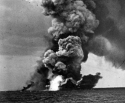 NS021338a |
526k | USS Franklin (CV-13) shown in smoke and flames as a result of an attack of Japanese dive-bomber which scored hits with two 500 lb. armor-piercing bombs, 19 March 1945. Photograph released 17 May 1945. National Archives and Records Administration (NARA) photo, # 80-G-49131. |
NARA | |
 NS021338 |
145k | A tremendous geyser of flame and smoke gushes skyward as one of the many explosions suffered by the ship detonates with shattering violence. Official US Navy photograph. (If you have any specific details concerning this photo, please contact us.) |
Robert M. Cieri | |
 NS021355 |
33k | USS Franklin (CV-13) is hit and set ablaze by a Japanese divebomber on March 19, 1945. Franklin was attacked by a single Japanese plane which dropped two armor-piercing bombs, devastating the hangar deck and setting off ammunition. Casualties totaled 724 killed and 265 wounded. |
Gerd Matthes, Germany | |
 NS021322 |
90k | Franklin hard hit, 19 March 1945, off Kyushu. She had been returned to service in January, following a kamikaze attack on 30 October (see above). USN photo, from the Naval War College. |
Joe Radigan | |
 NS021322a |
65k | USS Franklin (CV-13) burns after being hit by bombs dropped from Japanese aircraft, 19 March 1945. National Archives and Records Administration (NARA) photo, # 80-G-273867. |
Bill Gonyo | |
 NS021323 |
88k | Close up of the Franklin. BuShips described this fire as "the most severe survived by any U.S. warship during the course of World War II." USN photo, from the Naval War College. |
Joe Radigan | |
 NS021340 |
163k | Flames and smoke roll out of USS Franklin (CV-13) — with a river of burning gasoline spreading destruction as it streams out the side of the ship. Official US Navy photograph. |
Robert M. Cieri | |
 NS021310 |
80k | Ship's after 5"/38 twin gun mount burning, as her crew tried to control fires on 19 March 1945. The carrier had been hit by a Japanese air attack while operating off the coast of Japan. Photographed from USS Santa Fe (CL-60), which extinguished the fire in this gun mount by playing streams of water through the mount's open door. Later, the other 5"/38 twin gun mount and the 40mm quad machine gun mount (at right) also burned. Note ammunition loaded in the feed racks of the 40mm guns. Official U.S. Navy Photograph, now in the collections of the National Archives (photo # 80-G-273903). |
Scott Dyben | |
 NS021310a |
34k | Photo of Franklin taken from light cruiser USS Santa Fe (CL-60). |
Pieter Bakels | |
 NS021331a |
87k | USS Franklin (CV-13) burning off the Japanese coast after she was hit by air attack, 19 March 1945. Photographed from USS Santa Fe (CL-60), a few moments before picture NS021331. |
Pieter Bakels | |
 NS021331 |
100k | USS Franklin (CV-13) burning off the Japanese coast after she was hit by air attack, 19 March 1945. Photographed from USS Santa Fe (CL-60), which was alongside to help with firefighting and rescue work. Official U.S. Navy Photograph, now in the collections of the National Archives (photo # 80-G-273888). |
Tracy White | |
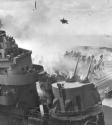 NS021327 |
208k | Seconds after an explosion hurls pieces of the flight deck and aircraft into the air, part of the crew runs for their lives. |
Courtesy of Scott Koen & ussnewyork.com | |
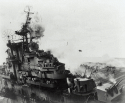 NS021327a |
692k | Tom Kermen Larger copy submitted by Bob Canchola, BT, USN (Ret.) |
||
 NS021327b |
449k | USS Franklin (CV-13) afire and listing after a Japanese air attack, 19 March 1945. National Archives and Records Administration (NARA) photo, # 80-G-273882. |
Courtesy of Scott Koen & ussnewyork.com | |
 NS021309c |
107k | Afire and listing after she was hit by a Japanese air attack while operating off the coast of Japan, 19 March 1945. Photographed from USS Santa Fe (CL-60), which was alongside assisting with firefighting and rescue work. David's older second cousin, Robert (Bobby) Woodell, was a sailor aboard Franklin on this date. |
David Buell | |
 NS021309d |
112k | |||
 NS021309 |
129k | Afire and listing after she was hit by a Japanese air attack while operating off the coast of Japan, 19 March 1945. Photographed from USS Santa Fe (CL-60), which was alongside assisting with firefighting and rescue work. Official U.S. Navy Photograph, now in the collections of the National Archives (photo # 80-G-273880). |
Scott Dyben Larger copy courtesy of Scott Koen & ussnewyork.com |
|
 NS021309a |
87k | USS Franklin, photographed from light cruiser USS Santa Fe (CL-60). |
Steve Whitby Larger copy submitted by Pieter Bakels |
|
 NS021309b |
93k | As above. |
Pieter Bakels | |
 NS021346 |
181k | Twisted and blackened, the debris aboard USS Franklin (CV-13) testifies to the force of the blasts and the heat of the flame that racked the carrier. Official U.S. Navy Photograph. |
Robert M. Cieri | |
 NS021326 |
79k | Dead in the water with a 14 degree list to starboard, with USS Santa Fe (CL-60) alongside. |
Steve Whitby | |
 NS021339 |
208k | USS Santa Fe (CL-60) maneuvers into position alongside USS Franklin (CV-13) disregarding all hazards in order to render aid needed. Official US Navy photograph. |
Robert M. Cieri | |
 NS021304 |
95k | The burning USS Franklin (CV-13) with USS Santa Fe (CL-60) alongside, transferring 833 nonessential crew members to safety aboard the cruiser while at the same time assisting in fire fighting. NS021304a: Roughly two thirds of Franklin's flight deck is on fire or smouldering in this aerial shot from an Essex (CV-9) aircraft. Santa Fe (CL-60) is alongside, trying to get water into the hangar deck through vents in the side of the ship. Navy photo now in the collections of NARA II, College Park, Maryland (# 80-G-373734). |
USN | |
 NS021304a |
186k | Gerhard Mueller‑Debus Larger copy submitted by Tracy White, Researcher @ Large |
||
 NS0406003 |
32k | USS Santa Fe (CL-60) assisting USS Franklin (CV-13) in fire fighting and rescue after the carrier was bombed and severely damaged off the island of Kyushu on 19 March 1945. |
USN | |
 NS021343 |
220k | Preparations are made for transfer of personnel, wounded and otherwise from the flight deck to USS Santa Fe (CL-60). Official US Navy photograph. |
Robert M. Cieri | |
 NS021342 |
158k | One of the casualties is transferred from USS Franklin (CV-13) to the cruiser USS Santa Fe (CL-60) after being given first aid treatment. Official US Navy photograph. |
Robert M. Cieri | |
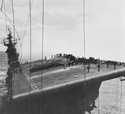 NS021303 |
214k | Dead in the water on March 19, 1945, the Franklin as seen from USS Santa Fe (CL-60) as the cruiser pulls away from the still burning carrier. |
Courtesy of Scott Koen & ussnewyork.com | |
 NS021347 |
153k | Listing badly, her flight deck a gaping ruin, USS Franklin (CV-13) says farewell to USS Santa Fe (CL-60) as the latter moves away; the skeleton crew left aboard Franklin soon started the tremendous task of repairing the boilers and engine rooms so that she could start the long trek home. Official US Navy photograph. |
Robert M. Cieri | |
 NS021344 |
213k | Exhausted by the shock of the explosions, and their efforts to quell the flames, survivors of USS Franklin (CV-13) rest on the deck of the cruiser USS Santa Fe (CL-60). Official US Navy photograph. |
Robert M. Cieri | |
 NS021341 |
100k | Lieutenant Commander Joseph T. O'Callahan, USNR(ChC) gives "Last Rites" to an injured crewman aboard USS Franklin (CV-13), after the ship was set afire by a Japanese air attack, 19 March 1945. The crewman is reportedly Robert C. Blanchard, who survived his injuries. Official U.S. Navy Photographs. Note: For his heroism on board Franklin, Lieutenant Commander O'Callahan was awarded the Medal of Honor. The escort ship USS O'Callahan (DE-1051, later FF-1051) was named after him. NS021314: National Archives and Records Administration (NARA) photo, # 80-G-49132. NS021336: National Archives and Records Administration (NARA) photo, # 80-G-K-5003-B. |
Robert M. Cieri | |
 NS021314 |
79k | Scott Dyben | ||
 NS021336 |
48k | NHC | ||
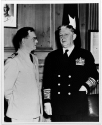 NS021336a |
194k | Commander Joseph T. O'Callahan, USNR(ChC), left, meets with Admiral Henry Kent Hewitt, in the Offices of the Chief of Naval Operations, circa summer 1945, following Admiral Hewitt's return to the United States from London and Chaplain O'Callahan's promotion to the rank of Commander. O'Callahan was awarded the Medal of Honor for heroism on board USS Franklin (CV-13), off Japan on 19 March 1945. U.S. Naval History and Heritage Command (NH&HC) Photograph, # NH 49175. Collection of Admiral Henry Kent Hewitt. |
Courtesy of Scott Koen & ussnewyork.com | |
 NS021337 |
115k | Photograph of LT Donald A. Gary, USN, taken circa 1945. Halftone reproduction, copied from the official publication "Medal of Honor, 1861-1948, The Navy", page 191. U.S. Naval History & Heritage Command (NH&HC) photo, (# NH 94631). Note: For his heroism on board Franklin, then Lieutenant (Junior Grade) Gary was awarded the Medal of Honor. The guided missile frigate USS Gary (FFG-51) was named after him. |
NH&HC | |
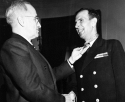 NS021337a |
204k | President Harry Truman presenting awards at a ceremony in the White House, 23 January 1946. Lieutenant Donald A. Gary, USN, hero of the Japanese aerial attack on USS Franklin (CV-13), is presented the Medal of Honor. Almost 300 men trapped in an isolated messing compartment below decks owe their lives to the Lieutenant, who discovered the only possible escape route for them through a ventilating tube and led them to safety. Official U.S. Navy photograph, now in the collections of the National Archives and Records Administration (NARA), # 80-G-701805. |
Courtesy of Scott Koen & ussnewyork.com | |
 NS021305 |
85k | One of the few portside views of the Franklin, as seen from USS Pittsburgh (CA-72), as the cruiser maneuvers to tow the carrier away from the Japanese mainland. | USN | |
 NS021348 |
122k | Still smoking, USS Franklin (CV-13) is towed from the scene of the disaster by the cruiser USS Pittsburgh (CA-72) before the crewmen aboard the carrier effected emergency engine repairs. Official US Navy photograph. |
Robert M. Cieri | |
 NS021349 |
199k | USS Pittsburgh (CA-72) tows USS Franklin after a dangerous starboard list had been corrected; she now is listing slightly to port but shortly afterward was able to continue under her own power because the propulsion mechanism had been repaired. Official US Navy photograph. |
Robert M. Cieri | |
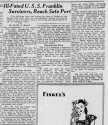 NS021365 |
289k | "Ill-Fated U.S.S. Franklin Survivors, Reach Safe Port" Newspaper clipping. |
Chris Novak, Webmaster/Historian, USS Bataan CVL-29 Reunion Association | |
 NS021306 |
82k | Under her own power and steaming at 14 knots, the Franklin is seen heading for Pearl Harbor for temporary repairs. The damage to the ship is evident, with the missing forward elevator and the shredded flight deck aft of the island. For watertight integrity and hull safety concerns, the starboard outboard elevator has been removed and nearly all of her 40mm mounts are gone too. | USN | |
 NS021311 |
751k | USS Franklin (CV-13) approaches New York City, while en route to the New York Navy Yard for repairs, 26 April 1945. Note the extensive damage to her after flight deck, received when she was hit by a Japanese air attack off the coast of Japan on 19 March 1945. Photographed by Naval Air Station Lakehurst, New Jersey. NS021311: Official U.S. Navy photograph, now in the collections of the National Archives (photo # 80-G-274014). |
Scott Dyben Bob Canchola, BT, USN (Ret.) |
|
 NS021311a |
31k | Tommy Trampp | ||
 NS021302 |
115k | Starboard view of USS Franklin (CV-13) at anchor in New York's lower harbor before moving upriver to the Navy Yard. Plated over positions below the island are removed 40mm gun mounts to allow her passage through the Panama Canal. | USN | |
 NS021307 |
145k | Rusty, battered and battle-scarred, but at home at last, USS Franklin drops anchor in New York harbor for permanent repairs, after a trip half way around the world. | USN | |
 NS021328 |
106k | New York Harbor, April 28th, 1945. |
Steve Whitby | |
 NS021328a |
220k | USS Franklin (CV-13) arrives at New York Navy Yard for repair of battle damage, circa 28 April 1945. Photographed looking aft, showing her burned-out after flight deck, with Manhattan beyond. Note oversize battle ensign flying from rear of her island. New York skyline and bridge in the distance, large American flag in foreground. National Archives and Records Administration (NARA) photo, # 80-G-K-5063. |
Yu Chu | |
 NS021328b |
528k | View of the wrecked flight deck aft of USS Franklin (CV-13) off Manhattan, 28 April 1945. |
Bob Canchola, BT, USN (Ret.) | |
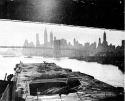 NS021328c |
134k | General view of flight deck aft as USS Franklin (CV-13) arrived at Navy Yard, New York. |
Mike Green | |
 NS021315 |
1.03M | View on the flight deck, looking forward, while the carrier was in New York Harbor, circa 28 April 1945. She had just returned from the Pacific for repair of battle damage received off Japan on 19 March 1945. Note damage to her flight deck, large U.S. ensign flying from her island, and the Manhattan skyline in the background. Official U.S. Navy Photograph, now in the collections of the National Archives and Records Administration (NARA), # 80-G-K-4760. |
Scott Dyben Bob Canchola, BT, USN (Ret.) |
|
 NS021316 |
798k | USS Franklin (CV-13) anchored in New York Harbor, upon her arrival from the Pacific for repair of battle damage, circa 28 April 1945. Official U.S. Navy Photograph, now in the collections of the National Archives and Records Administration (NARA), # 80-G-K-4771. |
Scott Dyben Bob Canchola, BT, USN (Ret.) |
|
 NS0401212 |
75k | USS Franklin (CV-13) (at left) steams past USS Marblehead (CL-12), in New York Harbor, circa 28 April 1945, after her arrival from the Pacific for battle damage repairs. Official U.S. Navy Photograph, now in the collections of the National Archives (photo # 80-G-K-4777). |
Tom Bateman | |
 NS021350 |
134k | "A Battle-Scarred Carrier Reaches Port for Repairs — Officers and men of the USS Franklin, Essex-class carrier, stand at attention on the flight deck as the ship reaches the Brooklyn Navy Yard on New York's East River front for repairs [note Williamsburg Bridge in the background.] Hit by two 500-pound bombs while participating in an attack against the Jap fleet in the Inland Sea, March 19, 1945, the Franklin, manned by a skeleton crew, sailed more than 12,000 miles to get home under her own power (AP)." (Released on Thursday, May 17.) Official US Navy photograph. |
Robert M. Cieri | |
 NS021321 |
71k | Official caption for photo NS021321 reads: "Church service on the ship's ruined hangar deck, taken upon her return to the U.S. from the Pacific for repair of battle damage received off Japan on 19 March 1945. Location is probably in, or near, New York Harbor, circa 28 April 1945." (Official U.S. Navy photograph, now in the collections of the National Archives, #80-G-K-5056.) However, the above information may be incorrect as far as location and date are concerned. According to "USS Franklin CV 13 WWII Cruise book," published in 1946 and written by LT Marvin K. Bowman, USN, advised and assisted by Mr. Paul Warrick of Atlanta, Ga.,
|
Naval History & Heritage Center | |
 NS021345a |
229k | Photos and excerpt from Cruise Book courtesy of Robert M. Cieri | ||
 NS021345 |
133k | |||
 NS021345b |
203k | |||
 NS021345c |
156k | |||
 NS021366 |
351k | USS Franklin (CV-13), Ship's Service Telephone Directory, probably burned after the kamika |
Steve Whitby | |
 NS021324 |
126k | Grainy but interesting shot of USS Franklin (CV-13) in drydock, New York, 1945. The entire flight deck and supporting upper hull was removed and rebuilt because of the extensive damage caused by two Japanese bombs that penetrated the flight deck, exploding on the hangar deck, igniting fuel and ordnance from the aircraft below decks. The circular rings to the left are the two forward 5" DP gun mount supports with the island superstructure behind them. The lower ring would be the flight deck level. U.S. Navy, National Archives photo. |
Steve Whitby | |
 NS021373 |
169k | USS Franklin (CV-13) under repair at the New York Naval Shipyard, 27 October 1945. The entire flight deck and supporting upper hull was removed and rebuilt because of the extensive damage caused by two Japanese bombs that penetrated the flight deck on 19 March 1945, exploding on the hangar deck, igniting fuel and ordnance from the aircraft below decks. |
Robert Hurst | |
 NS021370 |
15.6M | USS Franklin (CV-13) main deck/exterior bomb damage diagram from bomb strike on 19 March 1945 off Honshu. Bureau of Ships, USS Franklin (CV-13) War Loss/Damage Report No. 56, United States Navy. |
Mike Green | |
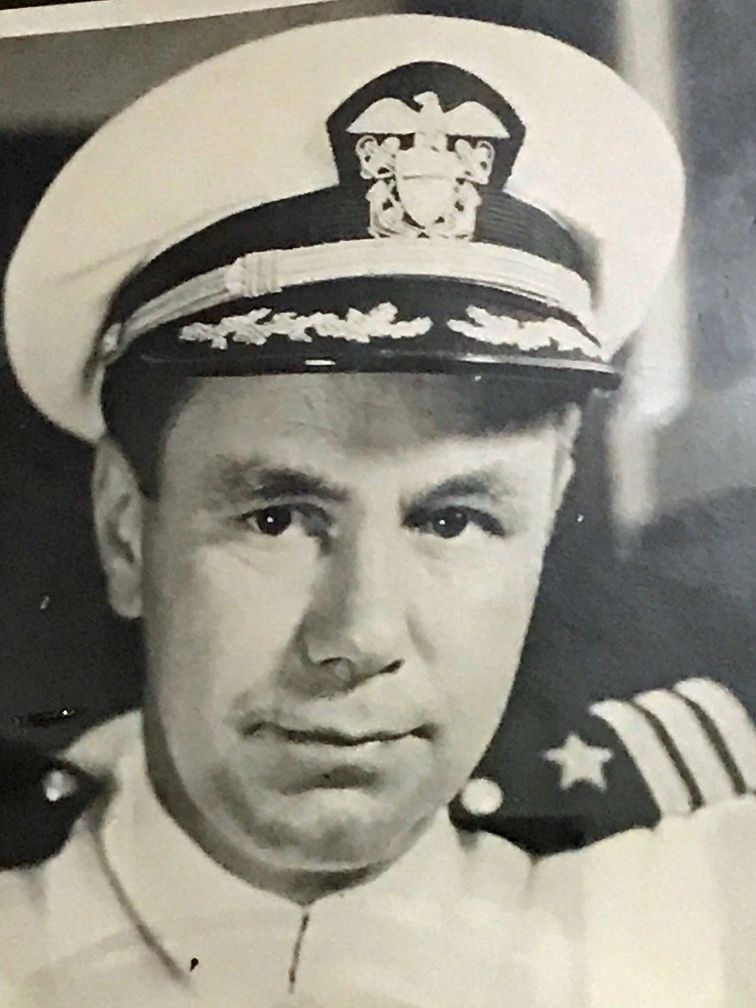 NSallen_joseph_s |
87k | Commander Joseph Steven Allen, then a Lieutenant, was a survivor of the attack on USS Franklin (CV-13). Photo courtesy of Naval Helicopter Association. |
Marianne Allen Abramov, Joe Allen's daughter |
|
| Related Links |
|
|
| Main Photo Index |
Aircraft Carrier Photo Index Page |
USS Franklin (CV-13) Main Page |
Comments, Suggestions or Image submissions, E-mail Carrier Information
Problems and site related matters, E-mail Webmaster
This page was created and is maintained by Fabio Peña
![]()
Last update: 1 May 2024